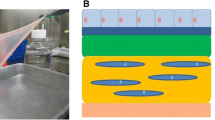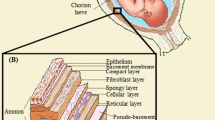Abstract
The human amniotic membrane (hAM), thanks to its favorable properties, including anti-inflammatory, anti-fibrotic and pro-regenerative effects, is a well-known surgical material for many clinical applications, when used both freshly after isolation and after preservation. We have shown previously that hAM patching is a potential approach to counteract liver fibrosis. Indeed, when fresh hAM was used to cover the liver surface of rats with liver fibrosis induced by the bile duct ligation (BDL) procedure, the progression and severity of fibrosis were significantly reduced. Since cryopreservation enables safety and long-term storage of hAM but may influence its functional properties, here we compared the anti-fibrotic effects of fresh and cryopreserved hAM in rats with BDL-induced liver fibrosis. After BDL, the rat liver was covered with a piece of fresh or cryopreserved hAM, or left untreated. Six weeks later, the degree of liver fibrosis was assessed histologically using the Knodell and the METAVIR scoring systems. Digital image analysis was used to quantify the percentage of the areas of each liver section displaying ductular reaction, extracellular matrix (ECM) deposition, activated myofibroblasts and hepatic stellate cells (HSCs). Liver collagen content was also determined by spectrophotometric technique. The degree of liver fibrosis, ductular reaction, ECM deposition, and the number of activated myofibroblasts and HSCs were all significantly reduced in hAM-treated rats compared to control animals. Fresh and cryopreserved hAM produced the same anti-fibrotic effects. These findings indicate that cryopreservation maintains the anti-fibrotic properties of hAM when used as a patch to reduce the severity of liver fibrosis.





Similar content being viewed by others
References
Bataller R, Brenner DA (2005) Liver fibrosis. J Clin Invest 115:209–218
Baum J (2002) Thygeson lecture. Amniotic membrane transplantation: why is it effective? Cornea 21:339–341
Beaussier M, Wendum D, Schiffer E, Dumont S, Rey C, Lienhart A, Housset C (2007) Prominent contribution of portal mesenchymal cells to liver fibrosis in ischemic and obstructive cholestatic injuries. Lab Invest 87:292–303
Beck PL, Lee SS (1995) Vitamin K1 improves survival in bile-duct-ligated rats with cirrhosis. J Hepatol 23:235
Benirschke K, Kaufmann P (2000) Pathology of human placenta. Springer, New York
Branski LK, Herndon DN, Celis MM, Norbury WB, Masters OE, Jeschke MG (2008) Amnion in the treatment of pediatric partial-thickness facial burns. Burns 34:393–399
Burman S, Tejwani S, Vemuganti GK, Gopinathan U, Sangwan VS (2004) Ophthalmic applications of preserved human amniotic membrane: a review of current indications. Cell Tissue Bank 5:161–175
Cargnoni A, Di Marcello M, Campagnol M, Nassuato C, Albertini A, Parolini O (2009) Amniotic membrane patching promotes ischemic rat heart repair. Cell Transplant 18:1147–1159
Chen YT, Li W, Hayashida Y, He H, Chen SY, Tseng DY, Kheirkhah A, Tseng SC (2007) Human amniotic epithelial cells as novel feeder layers for promoting ex vivo expansion of limbal epithelial progenitor cells. Stem Cells 25:1995–2005
Davis JS (1909) II. Skin grafting at the Johns Hopkins hospital. Ann Surg 50:542–549
Diaz-Prado S, Muinos-Lopez E, Hermida-Gomez T, Cicione C, Rendal-Vazquez ME, Fuentes-Boquete I, de Toro FJ, Blanco FJ (2011) Human amniotic membrane as an alternative source of stem cells for regenerative medicine. Differentiation 81:162–171
Dranoff JA, Wells RG (2010) Portal fibroblasts: underappreciated mediators of biliary fibrosis. Hepatology 51:1438–1444
Guyot C, Lepreux S, Combe C, Doudnikoff E, Bioulac-Sage P, Balabaud C, Desmouliere A (2006) Hepatic fibrosis and cirrhosis: the (myo)fibroblastic cell subpopulations involved. Int J Biochem Cell Biol 38:135–151
Hennerbichler S, Reichl B, Pleiner D, Gabriel C, Eibl J, Redl H (2007) The influence of various storage conditions on cell viability in amniotic membrane. Cell Tissue Bank 8:1–8
Hermans MH (2011) Preservation methods of allografts and their (lack of) influence on clinical results in partial thickness burns. Burns 37:873–881
Kesting MR, Wolff KD, Mucke T, Demtroeder C, Kreutzer K, Schulte M, Jacobsen F, Hirsch T, Loeffelbein DJ, Steinstraesser L (2009) A bioartificial surgical patch from multilayered human amniotic membrane-In vivo investigations in a rat model. J Biomed Mater Res B Appl Biomater 90:930–938
Kruse FE, Joussen AM, Rohrschneider K, You L, Sinn B, Baumann J, Volcker HE (2000) Cryopreserved human amniotic membrane for ocular surface reconstruction. Graefes Arch Clin Exp Ophthalmol 238:68–75
Kubo M, Sonoda Y, Muramatsu R, Usui M (2001) Immunogenicity of human amniotic membrane in experimental xenotransplantation. Invest Ophthalmol Vis Sci 42:1539–1546
Lee SB, Li DQ, Tan DT, Meller DC, Tseng SC (2000) Suppression of TGF-beta signaling in both normal conjunctival fibroblasts and pterygial body fibroblasts by amniotic membrane. Curr Eye Res 20:325–334
Liu J, Sheha H, Fu Y, Liang L, Tseng SC (2010) Update on amniotic membrane transplantation. Expert Rev Ophthalmol 5:645–661
Lo V, Pope E (2009) Amniotic membrane use in dermatology. Int J Dermatol 48:935–940
Lubel JS, Herath CB, Tchongue J, Grace J, Jia Z, Spencer K, Casley D, Crowley P, Sievert W, Burrell LM, Angus PW (2009) Angiotensin-(1–7), an alternative metabolite of the renin-angiotensin system, is up-regulated in human liver disease and has antifibrotic activity in the bile-duct-ligated rat. Clin Sci 117:375–386
Magatti M, De Munari S, Vertua E, Gibelli L, Wengler GS, Parolini O (2008) Human amnion mesenchyme harbors cells with allogeneic T-cell suppression and stimulation capabilities. Stem Cells 26:182–192
Manuelpillai U, Moodley Y, Borlongan CV, Parolini O (2011) Amniotic membrane and amniotic cells: potential therapeutic tools to combat tissue inflammation and fibrosis? Placenta 32(Suppl 4):S320–S325
Meller D, Pauklin M, Thomasen H, Westekemper H, Steuhl KP (2011) Amniotic membrane transplantation in the human eye. Dtsch Arztebl Int 108:243–248
Moon JH, Lee JR, Jee BC, Suh CS, Kim SH, Lim HJ, Kim HK (2008) Successful vitrification of human amnion-derived mesenchymal stem cells. Hum Reprod 23:1760–1770
Mucke T, Loeffelbein DJ, Holzle F, Slotta-Huspenina J, Borgmann A, Kanatas AN, Mitchell DA, Wagenpfeil S, Wolff KD, Kesting MR (2010) Intraoral defect coverage with prelaminated epigastric fat flaps with human amniotic membrane in rats. J Biomed Mater Res B Appl Biomater 95:466–474
Nakamura T, Yoshitani M, Rigby H, Fullwood NJ, Ito W, Inatomi T, Sotozono C, Shimizu Y, Kinoshita S (2004) Sterilized, freeze-dried amniotic membrane: a useful substrate for ocular surface reconstruction. Invest Ophthalmol Vis Sci 45:93–99
Niknejad H, Peirovi H, Jorjani M, Ahmadiani A, Ghanavi J, Seifalian AM (2008) Properties of the amniotic membrane for potential use in tissue engineering. Eur Cell Mater 15:88–99
Ogbureke KU, Fisher LW (2007) SIBLING expression patterns in duct epithelia reflect the degree of metabolic activity. J Histochem Cytochem 55:403–409
Parolini O, Alviano F, Bagnara GP, Bilic G, Buhring HJ, Evangelista M, Hennerbichler S, Liu B, Magatti M, Mao N, Miki T, Marongiu F, Nakajima H, Nikaido T, Portmann-Lanz CB, Sankar V, Soncini M, Stadler G, Surbek D, Takahashi TA, Redl H, Sakuragawa N, Wolbank S, Zeisberger S, Zisch A, Strom SC (2008) Concise review: isolation and characterization of cells from human term placenta: outcome of the first international Workshop on Placenta Derived Stem Cells. Stem Cells 26:300–311
Penz-Osterreicher M, Osterreicher CH, Trauner M (2011) Fibrosis in autoimmune and cholestatic liver disease. Best Pract Res Clin Gastroenterol 25:245–258
Petter-Puchner AH, Fortelny RH, Mika K, Hennerbichler S, Redl H, Gabriel C (2011) Human vital amniotic membrane reduces adhesions in experimental intraperitoneal onlay mesh repair. Surg Endosc 25:2125–2131
Popov Y, Schuppan D (2009) Targeting liver fibrosis: strategies for development and validation of antifibrotic therapies. Hepatology 50:1294–1306
Ramadori G, Saile B (2004) Portal tract fibrogenesis in the liver. Lab Invest 84:153–159
Rodriguez-Ares MT, Lopez-Valladares MJ, Tourino R, Vieites B, Gude F, Silva MT, Couceiro J (2009) Effects of lyophilization on human amniotic membrane. Acta Ophthalmol 87:396–403
Roskams T, Desmet V (1998) Ductular reaction and its diagnostic significance. Semin Diagn Pathol 15:259–269
Sakuragawa N, Kakinuma K, Kikuchi A, Okano H, Uchida S, Kamo I, Kobayashi M, Yokoyama Y (2004) Human amnion mesenchyme cells express phenotypes of neuroglial progenitor cells. J Neurosci Res 78:208–214
Sant’Anna LB, Cargnoni A, Ressel L, Vanosi G, Parolini O (2011) Amniotic membrane application reduces liver fibrosis in a bile duct ligation rat model. Cell Transplant 20:441–453
Sippel KC, Ma JJ, Foster CS (2001) Amniotic membrane surgery. Curr Opin Ophthalmol 12:269–281
Snowdon VK, Fallowfield JA (2011) Models and mechanisms of fibrosis resolution. Alcohol Clin Exp Res 35:794–799
Starkel P, Leclercq IA (2011) Animal models for the study of hepatic fibrosis. Best Pract Res Clin Gastroenterol 25:319–333
Tao H, Fan H (2009) Implantation of amniotic membrane to reduce postlaminectomy epidural adhesions. Eur Spine J 18:1202–1212
Turkay C, Yonem O, Arici S, Koyuncu A, Kanbay M (2008) Effect of angiotensin-converting enzyme inhibition on experimental hepatic fibrogenesis. Dig Dis Sci 53:789–793
Wells RG (2008) Cellular sources of extracellular matrix in hepatic fibrosis. Clin Liver Dis 12:759–768 (viii)
Wolbank S, van Griensven M, Grillari-Voglauer R, Peterbauer-Scherb A (2010) Alternative sources of adult stem cells: human amniotic membrane. Adv Biochem Eng Biotechnol 123:1–27
Acknowledgments
We thank the Department of Obstetrics and Gynecology of Fondazione Poliambulanza Istituto Ospedaliero, Brescia, Italy. We also thank Dr. Maddalena Caruso for helpful discussion and support in writing the manuscript and Dr. Marco Evangelista for help in editing the manuscript. This study was supported by grants from Fondazione Cariplo (Rif. 2006.0762/11.6457).
Conflict of interests
The authors confirm that there are no conflicts of interest.
Author information
Authors and Affiliations
Corresponding author
Rights and permissions
About this article
Cite this article
Ricci, E., Vanosi, G., Lindenmair, A. et al. Anti-fibrotic effects of fresh and cryopreserved human amniotic membrane in a rat liver fibrosis model. Cell Tissue Bank 14, 475–488 (2013). https://doi.org/10.1007/s10561-012-9337-x
Received:
Accepted:
Published:
Issue Date:
DOI: https://doi.org/10.1007/s10561-012-9337-x




